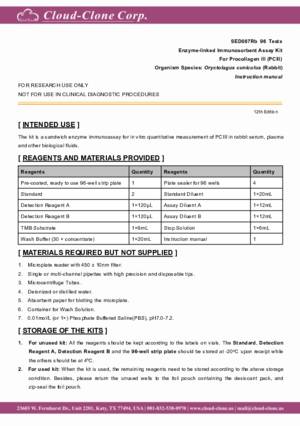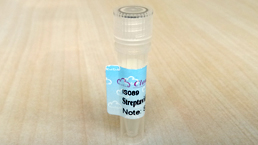Packages (Simulation)

Reagent Preparation

Image (I)
Image (II)
Certificate


ELISA Kit for Procollagen III (PCIII)
PCOL-III; PC-III; PC3; Type III Procollagen
- Product No.SED087Rb
- Organism SpeciesOryctolagus cuniculus (Rabbit) Same name, Different species.
- Sample TypeSerum, plasma and other biological fluids
- Test MethodDouble-antibody Sandwich
- Assay Length3h
- Detection Range0.156-10ng/mL
- SensitivityThe minimum detectable dose of this kit is typically less than 0.059ng/mL.
- DownloadInstruction Manual
- UOM 48T96T 96T*5 96T*10 96T*100
- FOB
US$ 532
US$ 760
US$ 3420
US$ 6460
US$ 53200
For more details, please contact local distributors!
Specificity
This assay has high sensitivity and excellent specificity for detection of Procollagen III (PCIII).
No significant cross-reactivity or interference between Procollagen III (PCIII) and analogues was observed.
Recovery
Matrices listed below were spiked with certain level of recombinant Procollagen III (PCIII) and the recovery rates were calculated by comparing the measured value to the expected amount of Procollagen III (PCIII) in samples.
| Matrix | Recovery range (%) | Average(%) |
| serum(n=5) | 96-104 | 101 |
| EDTA plasma(n=5) | 87-96 | 92 |
| heparin plasma(n=5) | 90-104 | 95 |
Precision
Intra-assay Precision (Precision within an assay): 3 samples with low, middle and high level Procollagen III (PCIII) were tested 20 times on one plate, respectively.
Inter-assay Precision (Precision between assays): 3 samples with low, middle and high level Procollagen III (PCIII) were tested on 3 different plates, 8 replicates in each plate.
CV(%) = SD/meanX100
Intra-Assay: CV<10%
Inter-Assay: CV<12%
Linearity
The linearity of the kit was assayed by testing samples spiked with appropriate concentration of Procollagen III (PCIII) and their serial dilutions. The results were demonstrated by the percentage of calculated concentration to the expected.
| Sample | 1:2 | 1:4 | 1:8 | 1:16 |
| serum(n=5) | 80-92% | 87-101% | 91-105% | 92-101% |
| EDTA plasma(n=5) | 97-105% | 97-104% | 81-99% | 96-105% |
| heparin plasma(n=5) | 89-101% | 87-94% | 79-92% | 98-105% |
Stability
The stability of kit is determined by the loss rate of activity. The loss rate of this kit is less than 5% within the expiration date under appropriate storage condition.
To minimize extra influence on the performance, operation procedures and lab conditions, especially room temperature, air humidity, incubator temperature should be strictly controlled. It is also strongly suggested that the whole assay is performed by the same operator from the beginning to the end.
Reagents and materials provided
| Reagents | Quantity | Reagents | Quantity |
| Pre-coated, ready to use 96-well strip plate | 1 | Plate sealer for 96 wells | 4 |
| Standard | 2 | Standard Diluent | 1×20mL |
| Detection Reagent A | 1×120µL | Assay Diluent A | 1×12mL |
| Detection Reagent B | 1×120µL | Assay Diluent B | 1×12mL |
| TMB Substrate | 1×9mL | Stop Solution | 1×6mL |
| Wash Buffer (30 × concentrate) | 1×20mL | Instruction manual | 1 |
Assay procedure summary
1. Prepare all reagents, samples and standards;
2. Add 100µL standard or sample to each well. Incubate 1 hours at 37°C;
3. Aspirate and add 100µL prepared Detection Reagent A. Incubate 1 hour at 37°C;
4. Aspirate and wash 3 times;
5. Add 100µL prepared Detection Reagent B. Incubate 30 minutes at 37°C;
6. Aspirate and wash 5 times;
7. Add 90µL Substrate Solution. Incubate 10-20 minutes at 37°C;
8. Add 50µL Stop Solution. Read at 450nm immediately.
GIVEAWAYS
INCREMENT SERVICES
| Magazine | Citations |
| Free Radical Biology & Medicine | Silybin combined with phosphatidylcholine and vitamin E in patients with nonalcoholic fatty liver disease: A randomized controlled trial PubMed: 22343419 |
| Intensive Care Medicine | Type III procollagen as a biomarker of susceptibility to ARDS? Pubmed:25617263 |
| European Journal of Gastroenterology & Hepatology | Measurements of serum procollagen-III peptide and M30 do not improve the diagnostic accuracy of transient elastography for the detection of hepatic fibrosis in patients with nonalcoholic fatty liver disease PubMed: 25923941 |
| Biomedicine & Pharmacotherapy | Bicyclol ameliorates advanced liver diseases in murine models via inhibiting the IL-6/STAT3 signaling pathway Pubmed:35658240 |
| Catalog No. | Related products for research use of Oryctolagus cuniculus (Rabbit) Organism species | Applications (RESEARCH USE ONLY!) |
| SED087Rb | ELISA Kit for Procollagen III (PCIII) | Enzyme-linked immunosorbent assay for Antigen Detection. |
| LMD087Rb | Multiplex Assay Kit for Procollagen III (PCIII) ,etc. by FLIA (Flow Luminescence Immunoassay) | FLIA Kit for Antigen Detection. |













